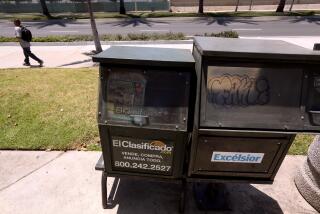Cities’ Bid to Share Taxes Founders on Great Divide
- Share via
In the self-centered and neighbor-elbowing climate of the state’s business and politics, the headline was a grabber.
“Stop the Warfare and Share the Wealth,” it read, referring to a possible agreement between Lancaster and Palmdale to share future sales-tax revenues. Such a pact would have been precedent-setting.
That was in July, when officials from the two Antelope Valley cities felt a surge of optimism about the plan, which they had hoped would end the competition for business that leads to costly bidding wars. Months later, the agreement has fallen through, leaving officials marveling at the elusiveness of civic cooperation.
“We had high hopes that this would come together,” Lancaster Mayor Frank Roberts said. “I’m disappointed that both sides couldn’t make it happen.”
Both sides say the door remains open for sharing ideas, and one new proposal is scheduled for discussion at Tuesday’s Lancaster City Council meeting. But it is far from certain that cities angling for the same precious sales-tax dollars--the largest source of municipal tax revenue allowed by the state--will ever find a way to unite.
Palmdale City Manager Robert Toone said the sticking point in the tax-sharing proposal was Lancaster’s “cockamamie” suggestion to freeze the sales tax at mid-1997 levels and split the revenues 50-50, rather than dividing them according to population.
“That’s an inequity that we have been unable to bridge,” Palmdale Mayor Jim Ledford said. “Simply sharing sales-tax revenue is easy. We could do it today. But I can’t sell [a 50-50 split] to my voters. They’re not going to buy that.”
The per-capita approach favored by Palmdale would require Lancaster to give Palmdale nearly $1 million in annual tax revenues, officials for both sides have concluded. Lancaster’s 1990 census population was 97,291; Palmdale’s 73,314.
Last year Lancaster took in nearly $10 million in sales-tax revenue; Palmdale more than $7 million.
Lancaster calls a per-capita arrangement a giveaway, but Palmdale counters that as it continues to grow, the tables will turn and it will then be the one sending money up north.
“We’re going to blow right past them in terms of population,” Toone said. A federal estimate of population as of Jan. 1, 1996, does show a narrowing of the gap--124,600 for Lancaster and 114,800 for Palmdale.
“I think that’s a little disconcerting for them, combined with the fact that people often don’t want to drive that extra 15 miles north to Lancaster,” Toone said.
In recent years Palmdale also has prevailed in attracting retailers. The Antelope Valley Mall, a major development off the Antelope Valley Freeway within Palmdale’s city boundaries, includes Dillard’s department store. And Sears and JCPenney moved from downtown Lancaster to Palmdale in the 1980s.
One compromise plan that may better suit both cities will be unveiled Tuesday at the Lancaster City Council meeting. Sponsored by Councilman Michael Singer, it would divide a portion of the tax revenues on a per-capita basis and leave the rest to be meted out 50-50. The two cities would have to agree on which businesses’ sales-tax revenues would be split per-capita.
Ledford and Lancaster Mayor Roberts last met to discuss revenue sharing in mid-August. Roberts said that meeting left him with the feeling that there was an agreement. But Ledford had a different impression.
“There was an agreement to pursue a solution,” Ledford said. “There was no agreement on the terms.”
The sharing concept has been bandied about for years in the Antelope Valley, where the relative proximity and isolation of Palmdale and Lancaster, the high desert area’s only two incorporated cities, have intensified the competition for business. Palmdale officials, prompted by changes on the Lancaster City Council, were the ones who revived the latest round of talks. Since August, however, they have canceled several meetings with Lancaster officials, citing impatience with what they consider their counterparts’ inflexibility.
“I didn’t think their [50-50] counterproposal was made in good faith,” Toone said. “I was frustrated with it, and quite frankly I have other things to do right now.”
Roberts asserted that Palmdale pulled out of the deal because its council members feared that as the smaller city, Palmdale would not get its fair share and did not want to risk the wrath of voters on Nov. 4. Mayor Ledford and two council members are seeking reelection.
Regardless of where the blame should lie, the deal’s failure illustrates the wariness with which the twin cities view each other--perhaps more warily, even they concede, than nearly any other pair of cities in Los Angeles County.
Since Palmdale incorporated in 1962 and Lancaster in 1976, they have traded blows on the business front. Several companies--car dealerships, in particular--have abandoned one town for a better deal with the other.
“We’re sort of isolated from everybody else,” Toone said. “You get a lot of cities competing around Los Angeles or San Diego, but they don’t go head-to-head all the time like we do.”
Dwight Stenbakken, legislative director for the League of California Cities, said he was not surprised that the revenue-sharing dream remains unrealized.
“You know what they say: ‘Your neighbors are the ones you fight with the most.’ And Lancaster and Palmdale are right next to each other.
“But,” he added, “it’s not uncommon to have these kinds of squabbles.”
The league, which represents most of California’s 471 municipalities, supports an amendment to the state Constitution proposed by Assemblyman George Runner (R-Lancaster), a former Lancaster mayor.
Runner’s bill, which will be taken up by the Legislature in January, would enable city governments to enact tax-sharing agreements without a public vote. All parties agree that voter approval of the type of agreement Lancaster and Palmdale were piecing together would not be easy to secure.
“We obviously much prefer to have local governments work out something at their level,” Stenbakken said, adding that such a scenario spurs regional economic growth.
Municipalities, in turn, have faulted the state for effectively turning neighbor against neighbor in the wake of Proposition 13 and other tax-limiting measures. Such an environment, they say, allows retailers to play one city against another for escalating tax breaks and infrastructure guarantees.
“The competition between us is based on how the system is set up in California,” Toone said.
Robert L. Scott, vice chairman of the Economic Alliance of the San Fernando Valley, acknowledged that in such a context, sharing will be difficult.
Nevertheless, he stressed, “I think it’s the wave of the future. More and more cities are going to try and get together to lure businesses based on the quality of the region, rather than trying to outbid one another.
“Most people from outside the area see Palmdale and Lancaster as a region anyway,” Scott added. “They look at the Antelope Valley as one contiguous region. The cities would be far better served to try to attract businesses together.”
Times staff writer Eric Slater contributed to this article.
More to Read
Inside the business of entertainment
The Wide Shot brings you news, analysis and insights on everything from streaming wars to production — and what it all means for the future.
You may occasionally receive promotional content from the Los Angeles Times.










